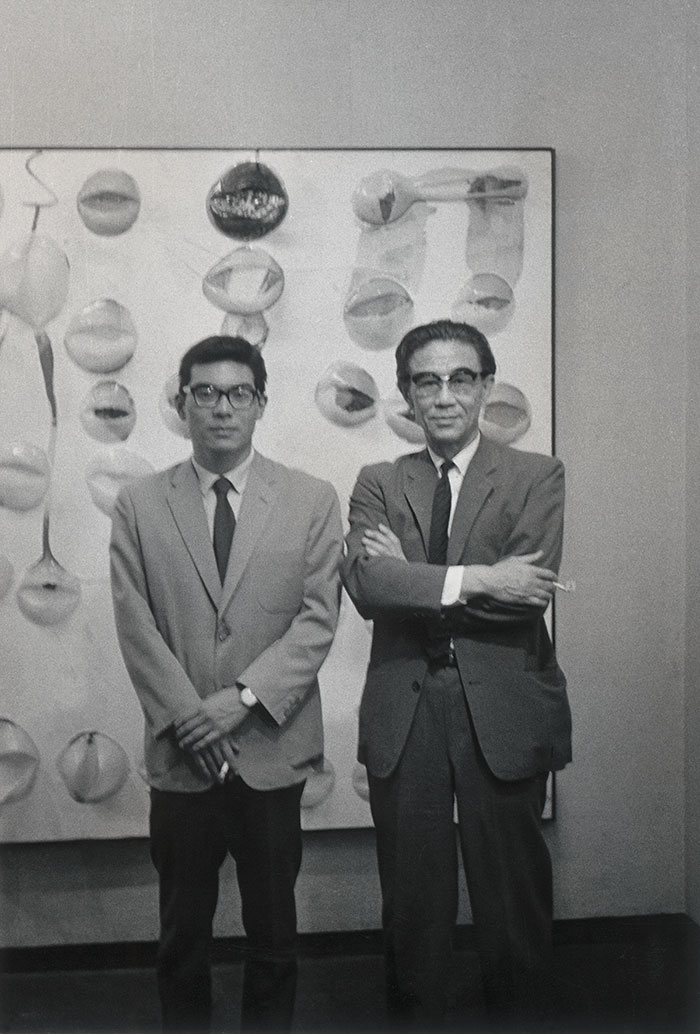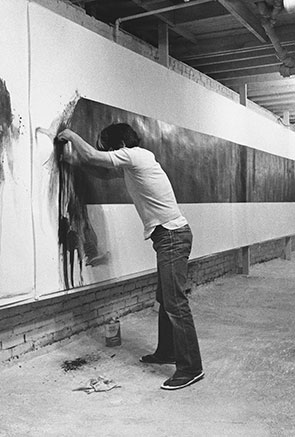Profile
Takesada Matsutani was born in Osaka in 1937. He contracted tuberculosis when he was fourteen and he fought the disease for eight years until he was twenty-two. For a period of time he was able to study classic Nihonga painting. In 1963, he joined Gutai (the Gutai Art Association), a group of artists who led the post war Japanese avant-garde art, and he began producing relief works using vinyl adhesive. In 1966 he moved to France, based in Paris, he began printmaking. In due course, he broke new ground with works formed from vinyl adhesive and covered with graphite pencil strokes. Even at the age of 87, Matsutani continues to work vigorously in Paris, demonstrating his vitality through his installations and performances.

1963
©Takesada Matsutani archives
- 1937
- Born in Abeno-ku, Osaka.
- 1951 (age 14)
- Contracts tuberculosis and fights the disease for eight years. During this time, he studies classical nihonga painting at Osaka Municipal Kogei High School but drops out after two years due to illness.
- 1959 (age 22)
- Completely recovers from tuberculosis. Meets Sadamasa Motonaga, a member of Gutai Art Association, at around this time.
- 1963 (age 26)
- Invited to be a member of Gutai Art Association he mounts a solo exhibition at Gutai Pinacotheca. Becomes renowned as a leading light of the second-generation Gutai artists, following in the footsteps of Kazuo Shiraga and Sadamasa Motonaga.
- 1966 (age 29)
- Wins first prize in the first-ever Mainichi Art Competition for exchange students selected by the French government and travels to France. In the following year he joins Atelier 17, a printmaking studio run by Stanley William Hayter.
- 1970 (age 33)
- Leaves Atelier 17 and moves to a silkscreen printmaking studio in Montparnasse. From this time through the 1980s, he wins numerous awards at international print exhibitions.
- Late 1970s
- Returns to his creative roots, using familiar materials such as pencil and paper, establishing a form of expression that fills the paper with black graphite strokes, engendering a representation of biological time. He also revisits organic forms made from vinyl adhesive, breaking new ground in his layered graphite stroke works. With a trajectory potentially stretching to infinity, the theme of “stream” becomes increasingly important. Matsutani continues to produce a wide variety of works, coming and going between various series and motifs.
- 2017 (age 80)
- Exhibits Venice Stream, a large-scale installation at the Viva Arte Viva arsenal exhibition of the 57th Venice Biennale.
- 2019 (age 82)
- Survey from the late 1950s to 2019 at the Centre Pompidou in Paris.

1967
©Takesada Matsutani archives

1981
©Takesada Matsutani archives

1982
©Takesada Matsutani archives

2001
©Takesada Matsutani archives
Photo: Yasushi Kanbe

Photo: Michel Lunardelli




